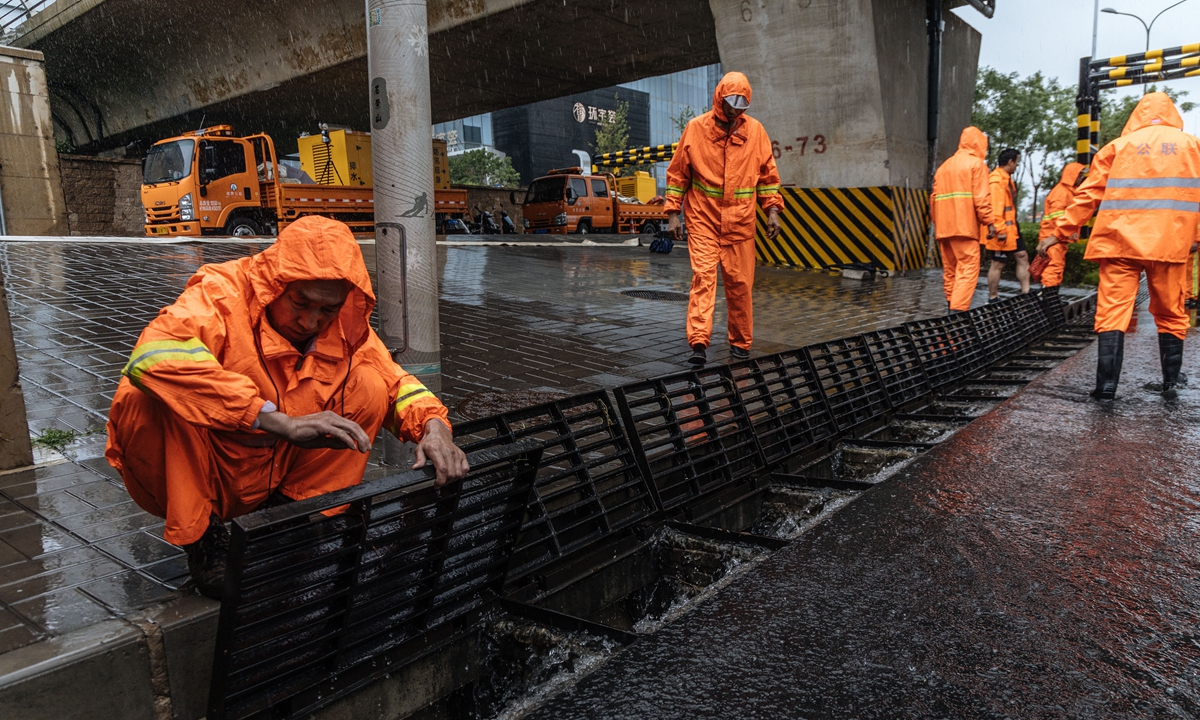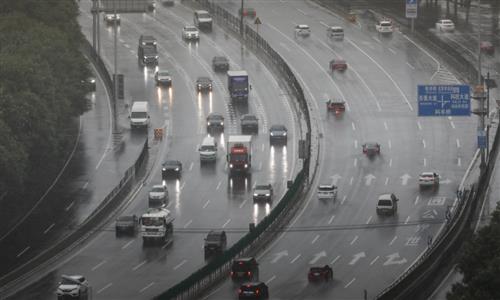Beijing soaked in heaviest rainfall in decade, on highest alert
Emergency response has come a long way since deadly 2012 disaster

Emergency response personnel stand ready at an underpass prone to waterlogging in Shijiangshan district in southwestern Beijing to prepare for emergencies on July 30, 2023 as the metropolis has posted a highest-level red alert for heavy rainstorms brought by the remnants of Typhoon Doksuri. Beijing authorities have been in full preparations for the heavy rainstorms that have swept across the city. Photo: Li Hao/GT
Beijing authorities and residents have been on high alert on Sunday for potential city inundation and flooding and debris flows in suburban areas, after a rare red alert for extreme weather was issued in the Chinese capital on Saturday.
As the remnants of Typhoon Doksuri ground up through southern and central China, meteorologists predicted that Beijing and northern China would be drenched with the heaviest rainfall in more than a decade. Doksuri slammed into the Chinese mainland in East China's Fujian Province on Friday, bringing heavy winds and flooding in its wake.
The National Meteorological Center (NMC) on Sunday maintained the highest-level red alert for rainstorms as provinces and regions close to Beijing are forecast to be hit heavily in the coming days.
The NMC issued the red alert on Saturday for only the second time since September 2011.
From 8 pm Saturday to 8 pm Sunday, the average accumulated rainfall in Beijing was 39.1 mm, with an average of 38.8 mm in urban areas. The heaviest rainfall was in the suburban Fangshan district, at 143.8 mm. Rainfall in Beijing is expected to continue until Wednesday morning, according to forecasts.
The heaviest rainfall in the Beijing-Tianjin-Hebei region occurred in Xingtai, Hebei Province, with 583.8 mm falling.
According to weather forecasts, heavy rain will continue to hit Beijing, Tianjin, Hebei and nearby provinces on Monday. Some areas will see extraordinarily heavy rainfall, with up to 400 mm of rainfall within 24 hours.
Many of those areas have an annual average rainfall of 400-600mm.
On Sunday afternoon, China's Ministry of Water Resources raised the emergency response for flood in Beijing-Tianjin-Hebei to Level II.
Warnings of gales, thunder and lightning and strong convective weather have been issued.
As of 12 pm Sunday, Beijing had received 13 flood control emergency reports, including 11 water-logged roads which stopped traffic and two geological disasters. None of the incidents resulted in casualties.
On Sunday afternoon, a flash flood occurred in a mountainous area of Fangshan district. The incident caused no casualties or property damage as all residents under threat were evacuated on Saturday.
Per NMC forecasts, the duration and amount of precipitation will surpass that of the rainstorm that lashed Beijing in July 2012, when the storm and secondary disasters claimed 79 lives, with large parts of the city under water.
As torrential rains brought back memories of the storm of July 21, 2012, the capital city's response to heavy rain has come a long way in comparison to 11 years ago, experts said.
Precaution measures
At known flood-prone spots in the city, municipal workers told the Global Times on Sunday that drainage and emergency equipment was put in place on Saturday before the rain arrived.
"Beijing Water Supply and Drainage Group and other related companies have formed several emergency rescue teams. We'll turn on the pumps according to the amount of rain and regularly clear blockages in the sewers," said a worker at one site.
Traffic police were standing at intersections prone to waterlogging, ready to divert traffic.
Authorities sent alerts via mobile phone text messages and other means to Beijing residents asking them to refrain from any non-essential outdoor activities on Sunday. Meanwhile, organized indoor and outdoor cultural, sports and recreational activities were suspended. Schools and kindergartens stopped all teaching activities, and after-school training organizations were asked to stop all on-site training.
Many employees told the Global Times they were notified to work from home on Monday, while parents of students received similar notices from schools.
According to announcements from major performance venues in Beijing, several indoor and outdoor concerts scheduled for Sunday were canceled, including a large-scale concert by popular singer Mao Buyi, which was expected to be attended by more than 10,000 people.
Scenic spots across the city and suburbs, including the Palace Museum and the Yonghe Lama Temple, will be closed on Sunday and Monday out of safety concerns.
However, residents were still out and about in indoor places. At noon on Sunday, a Global Times reporter saw almost as many people as normal shopping at a mall in Chaoyang district, with long lines at many popular restaurants.
Delivery drivers and couriers continued to serve customers in the rain, even though many netizens called on residents to minimize ordering services for their safety.
Traffic in downtown Beijing was smooth on Sunday. While there were far fewer cars on the road, buses and subways were operating normally. However, car-hailing apps had long queues of customers.
Extreme rainfall
The sting in the tail of Typhoon Doksuri has caused the rainfall of such extreme intensity and duration.
"Although the typhoon itself weakened rapidly, it is carrying an especially abundant amount of water vapor. In addition, its effect combined and reinforced the next typhoon, creating an effective water vapor transport that brought extreme amounts of rain," Ma Jun, director of the Beijing-based Institute of Public and Environmental Affairs, told to the Global Times on Sunday.
At the same time, the northern part of North China happens to be under the influence of high pressure, making it impossible for the rainfall to leave soon, Ma said.
Tropical Storm Khanan has formed in the Pacific and is on track to hit the mainland coast around East China's densely populated Zhejiang Province as early as Tuesday, Chinese forecasters said. It may strengthen to become a typhoon by the time it makes landfall.
Wang Gengchen, a research fellow at the Institute of Atmospheric Physics of the Chinese Academy of Sciences, pointed out that late July and early August every year is usually the most critical time for flood prevention and control in Beijing. However, this year's rainfall is still a very rare situation, with the amount of rainfall far exceeding the average for the same period in previous years, Wang told the Global Times.
Experts also warned that global climate change will lead to more extreme weather around the world.
The temperature of the entire planet is rising due to the warming effect caused by excessive greenhouse gas emissions. Current findings prove that there will be an increase in the frequency and intensity of extreme weathers in the future. This year's high frequency of extreme weather is a testament to that, Wang said.
Lessons from the past
Since the deluge of July 21, 2012 that battered Beijing, residents are always on their guard when a serious summer storm warning is issued.
In the wake of the painful lesson, Beijing enhanced its emergency response capacity for extreme precipitation.
Beijing has 155 sunken underpasses which are most prone to waterlogging. Since 2012, Beijing has made special efforts to strengthen the drainage and emergency response at these underpasses, Ma Jun said. Beijing also learned from the 2021 rainstorm disaster in Zhengzhou, where some subway tunnels were flooded, causing fatalities, and the capital city has made extra efforts to improve the safety of its subway lines.
The ability to monitor and forecast extreme weather has improved dramatically. With supercomputer calculations and forecasts, the city has a better understanding of actual rainfall and water levels in the city, and it has strengthened communication to the public and the warning system.
Ma said that Beijing's weather forecasts and citywide warning measures are issued in a very timely manner, which will expedite a better response to any disaster.



